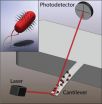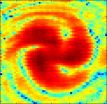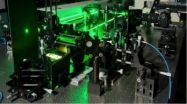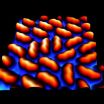Artworks are people!
2014-09-16
Not all things are created equally. We don't view a Picasso sculpture in the same way we look at a hammer, for example — no matter how fancy the hammer.
The reason? We see the Picasso more as a person than an object, according to new research from the University of Chicago Booth School of Business.
And in some cases, we make distinctions between artworks — say, an exact replica of a piece created by the artist, versus one created by a different artist.
Art, in other words, is an extension of the creator, write Professor Daniel M. Bartels of Chicago Booth, and Professor ...
For electronics beyond silicon, a new contender emerges
2014-09-16
Cambridge, Mass. – September 16, 2014 – Silicon has few serious competitors as the material of choice in the electronics industry. Yet transistors, the switchable valves that control the flow of electrons in a circuit, cannot simply keep shrinking to meet the needs of powerful, compact devices; physical limitations like energy consumption and heat dissipation are too significant.
Now, using a quantum material called a correlated oxide, Harvard researchers have achieved a reversible change in electrical resistance of eight orders of magnitude, a result the researchers ...
NASA's Global Hawk and satellites investigating Hurricane Edouard today
2014-09-16
The unmanned Global Hawk aircraft that's part of NASA's airborne Hurricane and Severe Storm Sentinel, or HS3 mission was winging its way to Hurricane Edouard on September 16. In addition to the Global Hawk, various NASA satellites are continually providing data on the Atlantic hurricane.
Scientific instruments aboard NASA's remotely piloted Global Hawk aircraft have been studying the hurricane over the last couple of days, and the Global Hawk returned to Edouard again today, September 16. Two of the instruments aboard the Global Hawk that will study Edouard are the S-HIS ...
Cancer patients with malignant spinal cord compression have preserved mobility
2014-09-16
San Francisco, September 15, 2014—Mobility is equally preserved in cancer patients suffering from malignant spinal cord compression (MSCC) who receive a single dose of 10 Gy of radiation therapy (RT), compared to patients who receive five daily doses of 4 Gy of RT each, according to research presented today at the American Society for Radiation Oncology's (ASTRO's) 56th Annual Meeting.
Malignant spinal cord compression (MSCC) is a complication of metastatic cancer mostly with bone involvement that occurs when a tumor's secondary deposit presses on the spinal cord and ...
And so they beat on, flagella against the cantilever
2014-09-16
WASHINGTON D.C., September 16, 2014 – A team of researchers at Boston University and Stanford University School of Medicine has developed a new model to study the motion patterns of bacteria in real time and to determine how these motions relate to communication within a bacterial colony.
The researchers chemically attached colonies of Escherichia coli bacteria to a microcantilever – a microscopic beam anchored at one end, similar to a diving board – thus coupling its motion to that of the bacteria. As the cantilever itself isn't doesn't generate any vibrations, or 'noise,' ...
NASA sees Tropical Storm Odile knocking at US Southwest
2014-09-16
Tropical Storm Odile continues to drench western Mexico and has now entered into the U.S. Southwest. On September 15, NASA's Terra satellite saw Odile's northernmost edge crossing the Mexican border into southern California. NOAA's GOES-East satellite on September 16 showed Odile's outer bands were already bringing storms to southern Arizona.
NASA Sees Odile Knocking on U.S. Border
On Sept. 15 at 2:35 p.m. EDT, the Moderate Resolution Imaging Spectroradiometer instrument aboard NASA's Terra satellite saw the northern fringes of Hurricane Odile straddling the border ...
Scientists twist radio beams to send data
2014-09-16
Building on previous research that twisted light to send data at unheard-of speeds, scientists at USC have developed a similar technique with radiowaves, reaching high speeds without some of the hassles that can go with optical systems.
The researchers, led by electrical engineering professor Alan Willner of the USC Viterbi School of Engineering, reached data transmission rates of 32 gigabits per second across 2.5 meters of free space in a basement lab at USC.
For reference, 32 gigabits per second is fast enough to transmit more than 10 hour-and-a-half-long HD movies ...
Kessler Foundation scientists link slowed processing speed with executive deficits in MS
2014-09-16
West Orange, NJ. September 16, 2014. Kessler Foundation researchers have published a study supporting the role of slowed processing speed in the executive deficits found in individuals with multiple sclerosis (MS). "Does slowed processing speed account for executive deficits in multiple sclerosis? Evidence from neuropsychological performance and structural neuroimaging," was published online ahead of print on August 18 by Rehabilitation Psychology The authors are Victoria Leavitt, PhD, of the Manhattan Memory Center, formerly of Kessler Foundation. Co-authors are Foundation ...
Tornadoes occurring earlier in 'Tornado Alley'
2014-09-16
WASHINGTON, D.C. – Peak tornado activity in the central and southern Great Plains of the United States is occurring up to two weeks earlier than it did half a century ago, according to a new study whose findings could help states in "Tornado Alley" better prepare for these violent storms.
Tornado records from Nebraska, Kansas, Oklahoma, and northern Texas – an area of high tornado activity dubbed "Tornado Alley" -- show that peak tornado activity is starting and ending earlier than it did 60 years ago.
Peak tornado activity, which occurs in the region from early ...
Water-based nuclear battery developed by MU can be used to generate electrical energy
2014-09-16
COLUMBIA, Mo. – From cell phones to cars and flashlights, batteries play an important role in everyday life. Scientists and technology companies constantly are seeking ways to improve battery life and efficiency. Now, for the first time using a water-based solution, researchers at the University of Missouri have created a long-lasting and more efficient nuclear battery that could be used for many applications such as a reliable energy source in automobiles and also in complicated applications such as space flight.
"Betavoltaics, a battery technology that generates power ...
Patients waiting too long to see doctor? Try 'just-in-time' management methods, researchers urge
2014-09-16
Using a pain clinic as a testing ground, researchers at Johns Hopkins have shown that a management process first popularized by Toyota in Japan can substantially reduce patient wait times and possibly improve the teaching of interns and residents.
In a report on the pilot study, published online Sept. 9, in Pain Medicine, the researchers adopted the so-called "Just-in-Time" training and inventory process used now by many manufacturers and service industries to stem waste and keep complicated operations from bottlenecking.
"We realized that a significant amount of time ...
Study on global carbon cycle may require reappraisal of climate events in Earth's history
2014-09-16
MIAMI – A recent study of the global carbon cycle offers a new perspective of Earth's climate records through time. Scientists at the University of Miami (UM) Rosenstiel School of Marine and Atmospheric Science suggest that one of the current methods for interpreting ancient changes in the concentration of carbon dioxide in the atmosphere and oceans may need to be re-evaluated.
The UM Rosenstiel School researchers measured the abundance of carbon-12 and carbon-13 isotopes in both the organic matter and carbonate sediments found in a nearly 700-meter marine sediment core ...
UCI team is first to capture motion of single molecule in real time
2014-09-16
Irvine, Calif., Sept. 16, 2014 – UC Irvine chemists have scored a scientific first: capturing moving images of a single molecule as it vibrates, or "breathes," and shifts from one quantum state to another.
The groundbreaking achievement, led by Ara Apkarian, professor of chemistry, and Eric Potma, associate professor of chemistry, opens a window into the strange realm of quantum mechanics – where nanoscopic bits of matter seemingly defy the logic of classical physics.
This could lead to a wide variety of important applications, including lightning-fast quantum computers ...
Making quantum dots glow brighter
2014-09-16
WASHINGTON, D.C., September 16, 2014 – Researchers from the University of Alabama in Huntsville and the University of Oklahoma have found a new way to control the properties of quantum dots, those tiny chunks of semiconductor material that glow different colors depending on their size. Quantum dots, which are so small they start to exhibit atom-like quantum properties, have a wide range of potential applications, from sensors, light-emitting diodes, and solar cells, to fluorescent tags for biomedical imaging and qubits in quantum computing.
A key property of quantum ...
Human faces are so variable because we evolved to look unique
2014-09-16
The amazing variety of human faces – far greater than that of most other animals – is the result of evolutionary pressure to make each of us unique and easily recognizable, according to a new study by University of California, Berkeley, scientists.
Our highly visual social interactions are almost certainly the driver of this evolutionary trend, said behavioral ecologist Michael J. Sheehan, a postdoctoral fellow in UC Berkeley's Museum of Vertebrate Zoology. Many animals use smell or vocalization to identify individuals, making distinctive facial features unimportant, ...
Gene variant that dramatically reduces 'bad' lipids
2014-09-16
Research using data collected from around 4,000 healthy people in the UK has enabled scientists to identify a rare genetic variant that dramatically reduces levels of certain types of lipids in the blood. The study is the first to emerge from the UK10K Project's cohort of samples from the general public and demonstrates the power of whole genome sequencing at scale.
"Until now it has only been possible to look for common variants of small effect in large genome wide association studies," says Dr Nicholas Timpson, first author from the Medical Research Council (MRC) Integrative ...
How learning to talk is in the genes
2014-09-16
Researchers have found evidence that genetic factors may contribute to the development of language during infancy.
Scientists from the Medical Research Council (MRC) Integrative Epidemiology Unit at the University of Bristol worked with colleagues around the world to discover a significant link between genetic changes near the ROBO2 gene and the number of words spoken by children in the early stages of language development.
Children produce words at about 10 to 15 months of age and our range of vocabulary expands as we grow - from around 50 words at 15 to 18 months, ...
The future face of molecular electronics
2014-09-16
WASHINGTON, D.C., September 16, 2014 --The emerging field of molecular electronics could take our definition of portable to the next level, enabling the construction of tiny circuits from molecular components. In these highly efficient devices, individual molecules would take on the roles currently played by comparatively-bulky wires, resistors and transistors.
A team of researchers from five Japanese and Taiwanese universities has identified a potential candidate for use in small-scale electronics: a molecule called picene. In a paper published September 16 in The Journal ...
Chemotherapy and SABR consecutively may be promising treatment option for advanced pancreatic cancer
2014-09-16
San Francisco, September 15, 2014— For patients with locally advanced pancreatic cancer, the combination of chemotherapy and stereotactic ablative radiation (SABR) may be a promising treatment option, ultimately allowing them to undergo surgery that may not otherwise be an option, according to research presented today at the American Society for Radiation Oncology's (ASTRO's) 56th Annual Meeting.
Surgery is the only potentially curative therapy for individuals with pancreatic ductal adenocarcinoma (PDA), the most common type of pancreatic cancer. However, pancreatic cancer ...
Job stress not the only cause of burnouts at work
2014-09-16
This news release is available in French. Montreal, September 16, 2014 — Impossible deadlines, demanding bosses, abusive colleagues, unpaid overtime — all these factors can lead to a burnout. When it comes to mental health in the workplace, we often forget to consider the influence of home life.
That's about to change, thanks to new research from Concordia University and the University of Montreal, which proves that having an understanding partner is just as important as having a supportive boss.
The study, published in the journal Social Psychiatry and Psychiatric ...
Evidence of genetic link to PTSD in soldiers exposed to childhood trauma
2014-09-16
September 16, 2014 -- While abnormalities in the adrenergic and noradrenergic systems, both integral in the fight-or-flight response, are thought to play a role in the development of post-traumatic stress disorder (PTSD), until now there has been no genetic evidence of this connection. A collaborative study just released by researchers at Columbia University's Mailman School of Public Health and the University of Michigan found an interaction between the ADRB2 gene and childhood adversity. For individuals with two or more experiences of childhood trauma, such as abuse, ...
Camera developed at WUSTL sheds light on mate choice of swordtail fish
2014-09-16
We have all seen a peacock show its extravagant, colorful tail feathers in courtship of a peahen. Now, a group of researchers have used a special camera developed by an engineer at Washington University in St. Louis to discover that female northern swordtail fish choose their mates based on a similar display.
Marine biologists at the University of Texas at Austin used a bioinspired polarization camera developed by Viktor Gruev, PhD, associate professor of computer science & engineering at Washington University, to make the discovery. His camera has been used in other ...
Ebola outbreak 'out of all proportion' and severity cannot be predicated
2014-09-16
A mathematical model that replicates Ebola outbreaks can no longer be used to ascertain the eventual scale of the current epidemic, finds research conducted by the University of Warwick.
Dr Thomas House, of the University's Warwick Mathematics Institute, developed a model that incorporated data from past outbreaks that successfully replicated their eventual scale.
The research, titled Epidemiological Dynamics of Ebola Outbreaks and published by eLife, shows that when applying the available data from the ongoing 2014 outbreak to the model that it is, according to Dr ...
Smoking and schizophrenia linked by alterations in brain nicotine signals
2014-09-16
Philadelphia, PA, September 16, 2014 – Schizophrenia is associated with increased rates and intensity of tobacco smoking. A growing body of research suggests that the relationship between schizophrenia and smoking stems, in part, from an effort by patients to use nicotine to self-medicate symptoms and cognitive impairment associated with the disease.
A new study, published in the current issue of Biological Psychiatry, sheds light on this hypothesis. The authors found that the level of nicotine receptors in the brain was lower in schizophrenia patients than in a matched ...
Pairing social networks with social motives to close the science gap
2014-09-16
Scientists make discoveries everyday, but that doesn't mean the findings are put into common practice.
In India, for example, the neonatal mortality rate is 10 times higher than in the developed world. While clinical trials found that applying an inexpensive topical solution of chlorhexidine to cleanse a newborn's umbilical cord reduced the neonatal mortality rate by 24 percent, many Indian parents did not receive or follow this information.
"The challenge is not that we don't have solutions to solve major societal problems, but that we struggle with how to take a ...
[1] ... [3211]
[3212]
[3213]
[3214]
[3215]
[3216]
[3217]
[3218]
3219
[3220]
[3221]
[3222]
[3223]
[3224]
[3225]
[3226]
[3227]
... [8701]
Press-News.org - Free Press Release Distribution service.










